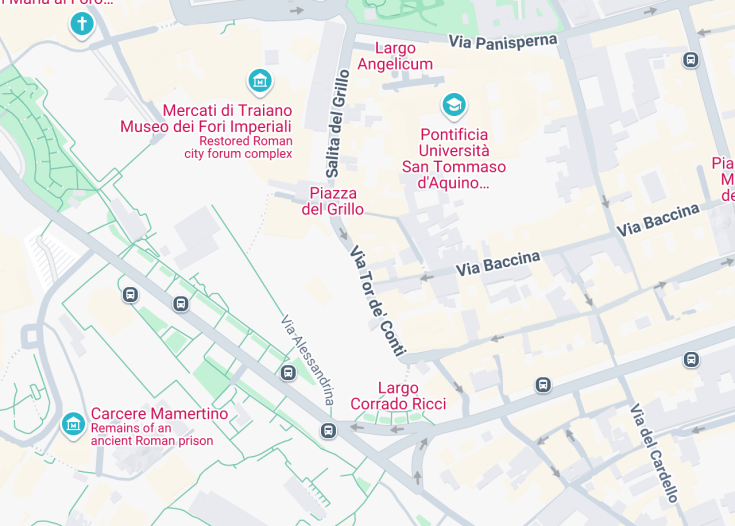The Arco dei Pantani, a historical monument nestled within the ancient precincts of Rome, stands as a testimony to the city’s rich imperial legacy. Originally constructed to celebrate the victories of Drusus and Germanicus, this arch served as a pivotal access point between the bustling Suburra and the illustrious Forum of Augustus. Today, visitors are drawn to its remaining grandeur, reflecting the architectural ingenuity of ancient Rome.
For an insightful experience, consider visiting the Arco dei Pantani during the early morning. The soft light enhances its features, and the area is less crowded, allowing for reflective moments amidst the historic ruins.
When preparing for your trip to the Arco dei Pantani, wear comfortable shoes to fully explore the surrounding archaeological sites. Take time to wander through the nearby Forum of Augustus, where ancient history comes alive.
Arco dei Pantani in Rome, Italy
The Arco dei Pantani is an ancient architectural structure located within the historical context of Augustus’ Forum, providing a unique insight into the urban landscape of ancient Rome. This arch, presenting a simple single archway with no ornate decorations, functioned as a crucial passageway linking the bustling district of the Subura to the fora. The arch stands as a testament to the engineering prowess and the aesthetic sensibilities of the time, connecting diverse regions of the city and facilitating movement for traders and citizens alike.
Constructed likely in the early 1st century AD, the Arco dei Pantani was positioned at the edge of the Forum, serving as a gateway where commerce and daily life intersected with imperial grandeur. This arch, initially known for its dedication to Germanicus, later bore the name “dei Pantani,” reflecting the marshy conditions that frequently plagued the surrounding area. The structure’s utilitarian design starkly contrasts with the opulence typical of contemporary arches and monuments, signaling its practical purpose amidst the grandeur of nearby structures.
Today, despite the ravages of time and the urban transformation of Rome, the arch remains an essential point of interest. It is surrounded by remnants of the former vibrancy of the district, adorned with archaeological markers that contextualize its historical significance, ensuring visitors can appreciate the rich narrative behind this ancient monument.
History
1st Century AD
Constructed during the reign of Augustus, the Arco dei Pantani served as a significant passageway between the Forum and the Subura. This period marked extensive urban development in Rome, characterized by the architectural innovation and the integration of public spaces, reflecting the emperors’ priorities in enhancing civic life.
Early Medieval Period
By the medieval era, the area around the Arco dei Pantani underwent significant transformations. The frequent floods and ensuing marshy conditions led to the arch being named for its association with the “pantani,” or swamps, which also contributed to its dilapidation and neglect. It became less significant in local memory as the population shifted and urban centers evolved.
Renaissance to Modern Era
During the Renaissance, the rediscovery of classical antiquity inspired renewed interest in Rome’s architectural heritage. The Arco dei Pantani was recognized for its historical value, driving archaeological efforts to unearth and preserve the site’s remnants. Continued excavations subsequently provided insights into its original context, revealing details about the life and commerce that surrounded it.
Activities at the Arco dei Pantani in Rome
Visitors to the Arco dei Pantani can engage in various activities that enrich their understanding of Rome’s historical landscape. Guided tours often include this landmark, providing context about its role within Augustus’ Forum. Photography opportunities abound, allowing tourists to capture the juxtaposition of ancient and modern Rome.
Exploring Surrounding Areas
The arch serves as a gateway to the adjacent Foro di Augusto and Foro di Nerva, inviting exploration of the expansive ruins and remnants of Roman architecture. Walking through the archaeological sites connects enthusiasts to the city’s vibrant history.
Connection to the Subura and Its Modern Implications
The Arco dei Pantani not only played a crucial role in the ancient urban fabric but also illustrates the ongoing relationship between geography and functionality in Rome. The arch’s historical significance remains evident in discussions about urban development, drainage, and public health in the context of the Subura. The transformation from a vibrant commercial hub to a lower-density area reflects broader trends in urbanization and the ever-changing dynamics of city life.
General informations
Location
The Arco dei Pantani is situated in the heart of ancient Rome, near the illustrious Foro di Augusto and the vibrant Suburra area. This historical arch once connected the bustling commercial district to the imperial fora, making it a strategic and symbolic location.
Address:
Via Tor de' Conti, 00184 Roma RM, ItalyVisiting Information
The Arco dei Pantani can be visited freely as it is located in a public area. For the best experience, consider visiting in the early morning or late afternoon when the light enhances the beauty of the archaeological site.
How to reach Arco dei Pantani
Car
The Arco dei Pantani is easily accessible by car. However, due to its central location, street parking can be challenging to find, and using public transportation is often recommended.
| Route | Distance | Travel time |
|---|---|---|
| From Termini Station | 1.5 miles (2.5 km) | 10 minutes |
| From Vatican City | 2.5 miles (4 km) | 15 minutes |
| From Fiumicino Airport | 18 miles (30 km) | 30 minutes |
Public Transport
The Arco dei Pantani is also accessible via Rome’s extensive public transport system. Taking the Metro is a popular option.
| Route | Line | Travel time |
|---|---|---|
| From Termini Station | Metro Line B | 5 minutes to Cavour Station |
| From Vatican City | Bus 81 or 492 | 15 minutes |
| From Fiumicino Airport | Leonardo Express to Termini, then Metro | 40 minutes |
Accessibility and Limitations
The Arco dei Pantani is generally accessible to visitors, but some areas may present challenges for those with mobility issues due to uneven terrain common in archaeological sites.
Accessibility
Limitations
- No seating available in the immediate area.
- Limited signage in languages other than Italian.
- Photographing is allowed, but tripods are prohibited.
Notes to visitors
- Be cautious of weather conditions; the area can become slippery when wet.
- Plan your visit during off-peak hours to fully appreciate the site.
- Respect the ongoing archaeological work in the vicinity.
Common questions
What are the architectural features of the Arco dei Pantani?
The Arco dei Pantani is a striking example of ancient Roman architecture, showcasing a simple yet imposing design typical of its time. It is characterized by a single, wide arch that spans a significant breadth, allowing for easy passage between the Suburra and the Fori Imperiali. The structure lacks elaborate decorations, which differentiates it from many of the more ornate triumphal arches scattered throughout Rome.
This arch originally featured a façade made of marble, some remnants of which can still be observed. Over time, the arch has suffered from degradation and wear, and much of its decorative elements have been lost. Despite its simplicity, it commands an impressive view toward the ancient ruins of the Forum of Augustus, accentuating its importance in the historical urban landscape.
Additionally, the arch’s robust construction utilizes large stone blocks, evidencing the engineering prowess of ancient Romans. Its positioning in a low-lying area, often impacted by flooding, has led to its nickname “Arco dei Pantani,” referencing the marshy terrain it once bridged.
What nearby attractions can visitors explore after seeing the Arco dei Pantani?
The area surrounding the Arco dei Pantani is rich with historical landmarks and attractions that enhance the Roman experience for visitors. After exploring this ancient arch, tourists can dive into a plethora of nearby historical sites.
- The Forum of Augustus: Located just adjacent to the arch, this forum is known for its spectacular ruins, including the large statue of Augustus and the remnants of the Temple of Mars Ultor.
- The Forum of Nerva: Also known as the Transitory Forum, this site is a short walk from the Arco dei Pantani and features intriguing archaeological vestiges that connect the history of the city from the time of Emperor Domitian to Nerva.
- The Colosseum: Approximately a 15-minute stroll from the Arco dei Pantani, the Colosseum is one of Rome’s most iconic landmarks, drawing countless visitors each year interested in its gladiatorial history.
- The Palatine Hill: Just beyond the Forum, the Palatine Hill offers stunning views over Rome and is steeped in myths surrounding the founding of the city. This area is filled with ruins of ancient palaces.
- The Capitoline Museums: Located not far away, these museums house extensive collections of art and archaeology, ideal for visitors keen on a deeper dive into Roman history.
Each of these attractions contributes to a rich tapestry of history, allowing visitors to seamlessly navigate the ancient world of Rome around the Arco dei Pantani, making for a comprehensive and enriching experience.
Are there any specific local customs or etiquette to observe when visiting the Arco dei Pantani?
When visiting the Arco dei Pantani in Rome, it is essential to be aware of local customs and etiquette to ensure a respectful and enjoyable experience. Italians value politeness and respect towards their historical sites, and those visiting should keep the following points in mind:
- Respect the Site: As the Arco dei Pantani is a historical monument, visitors should refrain from climbing on it or defacing its structure. Observe the site from designated areas to help preserve its integrity.
- Dress Appropriately: While there is no strict dress code, it’s best to dress modestly when visiting religious or historical sites in Rome. Comfortable shoes are advised due to the cobbled streets.
- Be Mindful of Noise: In keeping with the reverence for history, guests should maintain a respectful volume. This ensures the peace of others enjoying the site.
- Photography Etiquette: Taking pictures is generally welcomed, but it is courteous to be mindful of other visitors and not obstruct pathways or views while doing so.
- Engage with Local Guides: If interested, consider hiring a local guide for a detailed explanation of the arch’s significance. Local experts can enhance your understanding and appreciation of the site.
By observing these customs, visitors can enjoy their time at the Arco dei Pantani while showing respect for the rich history that it represents.
What is the best time of day to visit the Arco dei Pantani?
The best time to visit the Arco dei Pantani largely depends on personal preferences and the type of experience visitors wish to have. However, several factors can enhance the visit:
- Morning Hours: Early hours, especially right after opening, are ideal for those looking to avoid crowds. Visiting in the morning allows for a more intimate experience and better opportunities for photography before the influx of tourists.
- Golden Hour: Late afternoon, especially near sunset, is often considered the golden hour. The soft lighting enhances the beauty of the arch and surrounding ruins, providing stunning photographic opportunities against a backdrop of vibrant skies.
- Late Evening: For those who enjoy a quieter, more atmospheric experience, visiting later in the evening when the arch is softly illuminated can be magical. The cooler temperatures and reduced crowds offer a pleasant viewing experience.
Ultimately, the best time to visit the Arco dei Pantani is when it aligns with personal schedules and preferences, ensuring an enjoyable encounter with this ancient monument.
What photography tips can help capture the best images of the Arco dei Pantani?
When it comes to capturing the Arco dei Pantani in photographs, several tips can enhance the results, ensuring that visitors leave with memorable images of this iconic Roman landmark:
- Equipment: Use a DSLR or mirrorless camera for high-quality images, but smartphones can also yield excellent results. A tripod can be beneficial, especially during low-light conditions.
- Wide Angle Lens: A wide-angle lens can help capture the full expanse of the arch and its surroundings, making it easier to portray its grandeur and the context within the Roman Forum.
- Composition: Frame the arch using lines and edges from the surrounding structures to lead the viewer’s eye toward the arch. Consider incorporating elements like the sky or nearby ruins for added depth.
- Lighting Considerations: For the best results, visit during the golden hour—shortly after sunrise or before sunset—to take advantage of soft, warm lighting. This enhances the colors and textures of the stone structure.
- Experiment with Angles: Don’t hesitate to explore different angles and perspectives. Shooting from low angles can emphasize the height and majesty of the arch, while higher viewpoints can showcase the arch’s connection to the broader forum area.
These photography tips will help capture the essence of the Arco dei Pantani and create cherished memories of this historical site.

Is the Arco dei Pantani in Rome worth visiting?
The Arco dei Pantani, located near the bustling area of the Foro di Augusto, is a compelling historical monument that provides insight into ancient Roman architecture. Though it may not be as famous as the Colosseum or the Roman Forum, this arch connects the Foro di Augusto to the Suburra and is steeped in historical significance related to the ancient city.
Visitors interested in Roman history and archaeology will find the Arco dei Pantani fascinating, especially given its association with the Emperors Druso and Germanico. Plus, its location affords stunning views of the surrounding ruins. However, the lack of elaborate decorations may deter some tourists seeking more grand attractions. Those exploring the area will appreciate the chance to admire this hidden gem.









